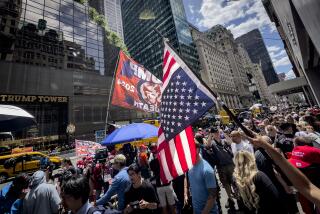Star-Bangled Banner Flags, Needs Face-Lift
- Share via
WASHINGTON — The Star-Spangled Banner, the majestic symbol of a young America’s victory in the War of 1812 and an icon of patriotism to generations of its citizens, is fraying.
The flag, which inspired Francis Scott Key to pen the national anthem, needs repairs because of age and the effects of temperature and light, according to the preliminary inspection by Smithsonian Institution experts. The flag is badly soiled on both front and back. The linen lining, installed by a group of “needlewomen” some 80 years ago, is showing its age. Some of the threads attaching the lining have broken. And the banner is stretched across an aluminum linen-covered frame that has begun to bow. The weight of the flag, according to the Smithsonian, is now supported on the sides and top. Linen tapes used for the installation are frayed and torn.
In addition, an examination showed traces of naphthalene, an insect repellent, on the flag. If not treated, its fibers could become brittle.
“Those factors pose grave risks to the stability of the flag,” said Ron Becker, associate director for capital programs at the Smithsonian’s National Museum of American History. “We will clean the flag, and one of the purposes of our conservation and consultation work is to conduct the necessary tests to determine the strength of the flag.”
For 89 years the flag has been a prized possession of the Smithsonian. For now, it will stay where it has been for the last 33 years, in the Museum of American History. But in order to decide how to protect the fragile flag for the future, the Smithsonian is organizing a conference for the end of November that will include specialists in fabric and flags, museum exhibits and climate-control systems. “And some who are interested in broad subject matter like the War of 1812,” Becker said.
“It is not in terrible condition. But we are in a place where it is appropriate for us to take stock of the situation for the long term,” Becker said. “We are investigating all the different approaches one might take.”
The flag was given to the Smithsonian in 1907 by the descendants of Maj. George Armistead, the commander of Ft. McHenry on Baltimore Harbor. The officer had ordered the flag in 1813, a year after the war began, so he could raise a banner the British couldn’t miss during what he hoped would be their retreat.
The sight of the 34-by-30-foot flag the morning after the decisive battle of Ft. McHenry in 1814 inspired Key to write his poem “The Star-Spangled Banner,” which was immediately set to music and in 1931 was confirmed by Congress as the country’s national anthem. “This was the flag that Francis Scott Key saw,” Becker said. “Since it rained that night, the flag that was flying during the bombardment would have been wet and plastered on the pole.”
Each day, thousands of tourists walk into the museum off the National Mall and stand in awe in front of the three-story space that holds the banner. During peak summer days, 17,000 people use that entrance to the museum.
To the untrained eye, the banner does not look dilapidated, but simply old, surprisingly dark and somewhat tattered. And even the tatters are ancient--one of the 15 stars was replaced in 1912 when a group of skilled seamstresses came to the Smithsonian and added the Irish linen backing. A red C-shaped patch appeared as early as 1874 on one stripe and a white spot has always been part of the star field. Part of the edge of the flag was cut away shortly after the Americans raised it on Sept. 14, 1814.
The banner is constantly monitored, Becker said, and this is not the first time aspects of the flag’s condition have caused alarm at the Smithsonian.
In 1982, the banner, showing wear and tear, was given a thorough preservation review. The flag remained in its current setting and the work was conducted from scaffolding. After it was cleaned with a hand vacuum, curators found that the residue contained particles of grass, leaves and blue cotton fibers.
Two years later, the flag was covered with an opaque screen to protect the fabric from light and dust. Once an hour the cover went up and down for a unobstructed view. After the screen’s cables broke and the screen fell in the spring of 1994, exposing the flag constantly to light and air, the Smithsonian began a series of internal discussions about its presentation. (The flag was not harmed in this mishap.)
“In the time since, technology has improved so much that we think we can do a much better housing of the flag,” Becker said. Covering it with glass, perhaps making both the front and back visible, is an option. “We are going to leave no stone unturned to put the flag in the best possible housing.”
The conference, to be held here Nov. 22 and 23, will examine the flag’s preservation, presentation, accompanying interpretation and options for the exhibit space itself. It is a main thoroughfare and the possibility of a complete redesign will be examined.
The Smithsonian, Becker said, will then choose a course and launch a national fund-raising drive to cover the costs.
The whole planning process, according to the Smithsonian, could take a year.
More to Read
The biggest entertainment stories
Get our big stories about Hollywood, film, television, music, arts, culture and more right in your inbox as soon as they publish.
You may occasionally receive promotional content from the Los Angeles Times.










